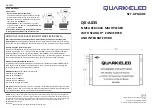
9
PL
GB
O P E R A T I N G M A N U A L
sion of measurements, it is recommended to replace the battery as soon as possible once the symbol of battery has been displayed.
Replacement of the fuse
The device is equipped with a 0.5A/250V (Ø5x20mm) quick-break equipment fuse. If the fuse is damaged, it must be replaced with a
new one of the same electrical parameters. To do so, open the housing of the meter and proceed as in the case of replacement of the
battery, observing the safety principles, to replace the fuse.
The 5A/250V (Ø5x20mm) fuse must be replaced in a specialised repair shop.
Connection of the test leads
Remove the protection caps from the plugs and connect them in accordance with the instructions. Then remove the protections of the
measurement part and proceed to measurements.
Depending on the actual position of the measurement range selector in the display three significant digits will be displayed. If it is
necessary to replace the battery the multimeter indicates this displaying the battery symbol. If the measured value is preceded by the
“-” symbol, then the measured value has an opposite polarization in relation to the connection of the meter. If only “1” is displayed, then
the measurement range is exceeded, and it is necessary to increase the measurement range. In case of measurements of quantities
of unknown values, set the highest measurement range and only after the initial measurement change the measurement range to the
adequate one.
ATTENTION! The measurement range of the meter must not be lower than the measured value. It might damage the meter
and cause an electric shock.
The correct connection of the leads:
The red lead must be connected to the socket marked as „V
Ω
mA”, „5A”
The black lead must be connected to the socket marked as „COM”
In order to ensure the highest possible precision of the measurements the optimum measurement conditions must be observed: ambi-
ent temperature between 18°C and 28°C and relative humidity <75 %
Example of determination of precision
Precision: ± % of the indi weight of the least significant digit
Measurement of the direct voltage: 1.396 V
Precision: ± (0.8% + 5)
Calculation of the error: 1.396 x 0.8% + 5 x 0.001 = 0. 0.005 = 0.016168
Result of the measurement: 1.396 V ± 0.016 V
Measurements of voltage
Connect the measurement cables to the sockets marked as „V
Ω
mA” and „COM”. Switch the measurement range selector to the posi-
tion of the measurement of the direct voltage or alternating voltage. Select the maximum measurement range, connect the measure-
ment cables in parallel to the electric circuit and read the result of the measurements of the voltage. In order to ensure more precise
results of the measurement you may change the measurement range. Do not ever measure a voltage exceeding 500 V in case of
measurements of the direct voltage and 500 V rms (square average) in case of measurements of the alternating voltage. It might
damage the meter and cause an electric shock.
Measurement of intensity of the current
Depending on the expected value of the measured intensity of the current connect the measurement cables to the socket marked as
„V
Ω
mA” and „COM” or to the socket marked as „5A” and „COM”. Select the adequate measurement range using the measurement
range selector and the kind of the measured current.
Maximum intensity of the current measured through the „V
Ω
mA” socket may amount to 200 mA. In case of measurements of the cur-
rent exceeding 200 mA connect the lead to the socket marked as „5A”. Maximum intensity of the current measured through the socket
marked as „5A” may amount to 5 A, while the duration of measurement must not exceed 10 seconds, and it is required to wait at least
15 minutes before the next measurement.
The maximum current and voltage values of the sockets must not be exceeded.
Con-
nect the measurement cables in series to the tested electric circuit, select the range and kind of the current and read the result of the
measurement. The first stage of the measurements is to select the maximum measurement range. In order to ensure more precise
results of the measurement you may change the measurement range.
Measurements of resistance
Connect the measurement cables to the sockets marked as „V
Ω
mA” and „COM”; switch the measurement range selector in the posi-
tion of the measurement of resistance. Place the measurements leads at the terminals of the measured element and read the result. In
order to ensure more precise results of the measurement the measurement range may be changed if required.
It is strictly prohibited
to measure the resistance of live elements.
In case of measurements of values exceeding 1M
Ω
the measurement may take a
couple of seconds before the result is stable, which is a normal reaction during measurements of high resistances.










































